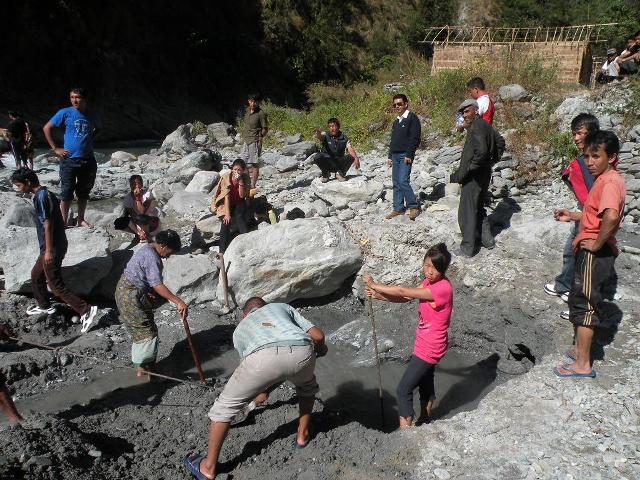Sajjad Hussain/Agence France-Presse
Getty Images An artwork on display at the India Art
Fair, which opened in New Delhi on Friday.
Source NYTIMES
NEW DELHI —All roads in Delhi lead to the Okhla Industrial Estate this
weekend, where the
India Art
Fair opened to the public on Friday.
At a preview on Thursday, a well-heeled crowd took in over 3,000 works of art
by 105 exhibitors from 24 countries. Eleven interactive art projects, works on
loan from the artists, are also on display, as well as Jitish Kallat’s
installation of Mohandas K. Gandhi’s letter to Adolf Hitler advising him against
war.
Although there’s plenty of art to take in amid all the air-kissing society
folks, be sure to wander past the following booths:
GALLERYSKE: The gallery’s director, Sunitha Kumar Emmart,
shows a stellar lineup of contemporary artists, including Sudarshan Shetty,
Srinivasa Prasad and Prabhavathi Meppayil.
Where: booth C-2.
Gallery Espace: Works by Zarina Hashmi, who is currently
showing at the Guggenheim Museum in New York, Nilima Sheikh, Rajinder Tikoo and
Rina Banerjee.
Where: booth B-2.
Samdani Art Foundation: The nonprofit based in Dhaka,
Bangladesh, has on display “My Daughter’s Cot,” a baby crib made of stainless
steel razor blades, by the artist Tayeba Begum Lipi.
Where: booth
D-6.
Tasveer: Powerful photography and photo-based art by
Maimouna Guerresi, Steve McCurry and Raghu Rai.
Where: booth D-9.
Photoink: Great photography, with Vivan Sundaram riffing on
the work of his late aunt, Amrita Sher-Gil, and compelling contemporary photos
by Dhruv Malhotra.
Where: booth F-7.
Seven Art: A must-see is Martand Khosla’s “Site Reconsidered
2,” made of brick dust.
Where: Booth C-15.
Scream of London: Pakpoom Silaphan’s “
Triple Gandhi on Pepsi” attracted a lot of eyeballs. The
gallery’s works have already sold out, according to the fair’s founder, Neha
Kirpal.
Where: booth A-5.
Imaginart Gallery/Tasneem Gallery: Big-name Spanish artists
you don’t typically get to see in India, including works by Salvador Dalí and
Pablo Picasso.
Where: booth B-9.
TAG Fine Arts: A wall of black butterflies created by Jane
Dyer.
Where: booth D-5.
Dhoomimal Art Center: A collection of the Indian master
Jamini Roy’s works, from the early 1900s to the 1950s.
Where: booth J-2.
The Swiss curator Mirjam Varadinis is offering curated walks through the
fair.
There are also several don’t-miss Speakers Forum talks:
“Art in the Age of Uprising” includes panelists Ravi Sundaram, a senior
fellow at the Center for the Study of Developing Societies; Chus Martínez, chief
curator of the El Museo del Barrio in New York, and Juan Gaitán, the curator of
the 8th Berlin Biennale for Contemporary Art. Monica Juneja, chairwoman of
global art history at Heidelberg University in Germany, moderates.
When:
Saturday, Feb. 2, noon to 1:30 p.m.
“The Museum of the 21st Century: A Working Model?” includes panelists Barbara
London, a curator from New York’s Museum of Modern Art, Liu Yingjiu, from the
Rockbund Art Museum in Shanghai, Sandhini Poddar, from the Guggenheim in New
York, and Professor Tapati Guha-Thakurta of Kolkata. Professor Kavita Singh of
New Delhi’s Jawaharlal Nehru University moderates.
When: Sunday, Feb. 3,
noon to 1:30 p.m.
There are also various events and in and around Delhi timed to the fair:
This year’s four finalists for the Skoda Prize for Indian Contemporary Art
offer something for everyone at the
National Gallery of Modern Art. Curated by Girish Shahane, the
exhibit includes art by a younger set of contemporary artists, including Shilpa
Gupta, L.N. Tallur, Srinivasa Prasad and CAMP. Kids especially will love Mr.
Prasad’s “Igloo” and “Rebirth,” both of which involve climbing in and out of
structures.
At the
Indira Gandhi National
Center for the Arts, “Homelands,” a British Council-sponsored exhibit
curated by Latika Gupta, explores the idea of nationality, home and identity in
80 works of photography, painting, sculpture and video, many shown for the first
time in India.
If you’re an audio buff, don’t miss an “Evening of Sound” on Feb. 2,
organized by the artists’ residency
Khoj. Arrive at their newly renovated studio, across the
street from Select City Walk Mall in Saket at 6 p.m. to hear live performances
by Chi-Wei Lin, Rudi Punzo and Robert Millis, then wander to nearby DT Cinemas
to hear a sound exhibition curated by Alexis Bhagat and Lauren Rosati.
Khoj’s studio is at S-17, Khirkee Extension.







